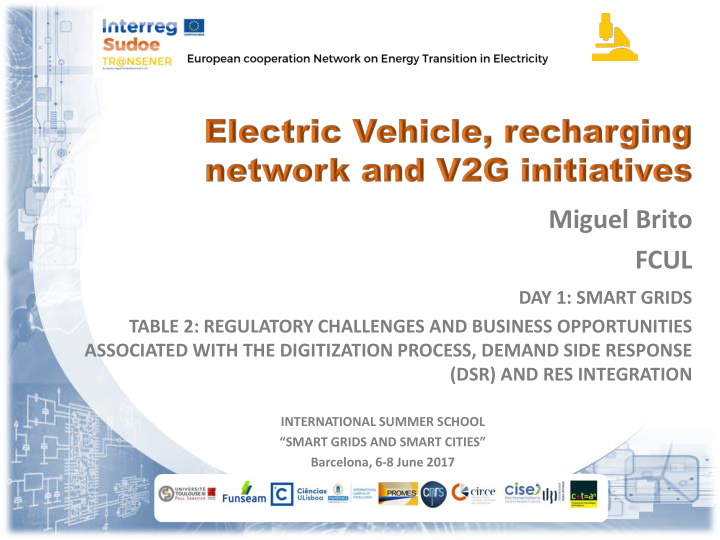



Miguel Brito FCUL DAY 1: SMART GRIDS TABLE 2: REGULATORY CHALLENGES AND BUSINESS OPPORTUNITIES ASSOCIATED WITH THE DIGITIZATION PROCESS, DEMAND SIDE RESPONSE (DSR) AND RES INTEGRATION INTERNATIONAL SUMMER SCHOOL “SMART GRIDS AND SMART CITIES” Barcelona, 6-8 June 2017
Conventional stationary plugin charging can be inconvenient, requires time to recharge vehicle and often leads to range anxiety
Conventional stationary plugin charging can be inconvenient, requires time to recharge vehicle and often leads to range anxiety. Dynamic charging promises long-range anxiety-free EV travel with minimal on-board energy storage. 2km electrified transportation corridor for heavy trucks in Gävleborg (Sweden)
Conventional stationary plugin charging can be inconvenient, requires time to recharge vehicle and often leads to range anxiety. Dynamic charging promises long-range anxiety-free EV travel with minimal on-board energy storage. Flexible solution with hybrid vehicles (disconnects for overtaking or when moving to other roads) ‘High’ efficiency charging (lower than when plugged in the carport!)
Conventional stationary plugin charging can be inconvenient, requires time to recharge vehicle and often leads to range anxiety. Dynamic charging promises long-range anxiety-free EV travel with minimal on-board energy storage. Energies 2016, 9(7), 483; doi:10.3390/en9070483
Conventional stationary plugin charging can be inconvenient, requires time to recharge vehicle and often leads to range anxiety. Dynamic charging promises long-range anxiety-free EV travel with minimal on-board energy storage. Especially applicable to fixed route vehicles (e.g. buses) 1min opportunity charge at 40kW extends the range in 1km Lower SOC range due to frequent charging > increased lifetime Smaller battery > lightweight > lower consumption Lower charging efficiency, offsetting battery size benefit Plugin buses charge overnight whilst dynamic charging >50% during daytime On-board supercapacitor, to protect battery from transient pulses Wider and more expensive infrastructure (5-10x more chargers)
Korea Advanced Institute of Science and Technology
Project Start year Location Efficiency Power (kW) Bus projects in Italy 2003 Turin, Italy 90% 60 KAIST On-Line Electric Vehicle 2009 South Korea 72 – 83% 6 – 100 (OLEV) Bombardier PRIMOVE IPT for 2010 Germany, Belgium >90% 40 – 200 Electric Buses Chattanooga Area Regional United States 2011 90% 60 Transportation (TN) Authority (CARTA) Wireless Advanced Vehicle United States 2012 90% 25 – 50 Electrification (UT, CA, TX, MD) (WAVE) ZTE Corporation China (various 2014 90% 30 – 60 projects cities)
DWC infrastructure costs: 1.5M$/lane/km including road retrofitting (50%) WPT electronics (40%) grid connection (10%) Optimization: vehicles with 40km range (6 kWh batteries) 50kW in-motion charging on 12% of paved roadways (capital investment 725b € ) DWC is (assumed to be) determined by light duty vehicles due to higher consumption
30% penetration rate required for acceptable societal cost Transition might require hybrid vehicles/charging solutions BJ Limb et al, Emerging Technologies: Wireless Power Transfer (WoW), 2016 IEEE PELS Workshop on
Life cycle analysis Bi, Z., De Kleine, R. and Keoleian, G. A. (2017. Journal of Industrial Ecology, 21: 344 – 355. doi:10.1111/jiec.12419
Vehicle to grid ( V2G ) Enhanced flexibility for management of system energy Large penetration of (smart charging) EV reduces the relevance of this flexibility (if all cars stop charging together the available power surge can face any change in variable renewables) Increased cycles reduce battery lifetime (issue if driver owns battery) Stationary WPT not suitable (but not impossible) for V2G Battery swapping assumes on-road power stations with interesting business model for centralized large scale energy storage and grid ancillary services
Recommend
More recommend